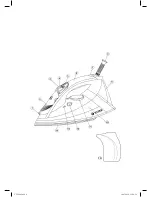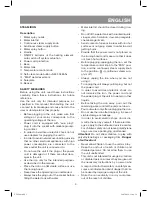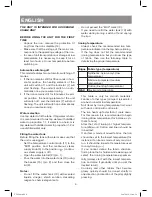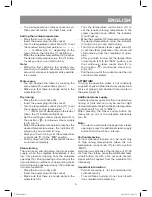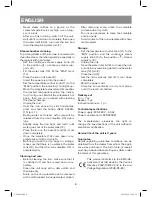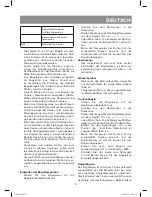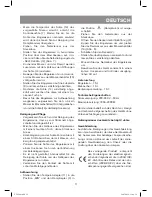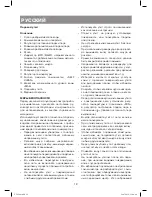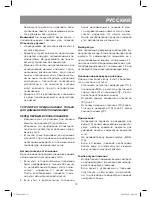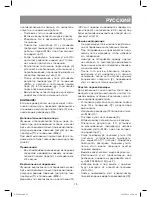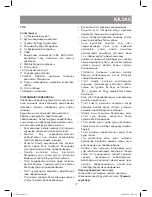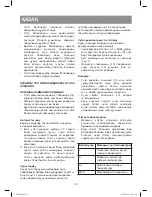
4
ENGLISH
THE UNIT IS INTENDED FOR HOUSEHOLD
USAGE ONLY
BeFore USinG tHe Unit For tHe FirSt
time
–
Unpack the iron; remove the protection (if
any) from the iron soleplate (14).
–
Make sure that the voltage of the mains cor-
responds to the operating voltage of the iron.
–
In case of unit transportation or storage at low
temperature it is necessary to keep it for at
least two hours at room temperature before
switching on.
automatic switching off
This model features two automatic switching off
modes.
1.
If the iron remains still for 30 seconds in hori-
zontal position, the heating element of the
unit will switch off, and the indicator (7) will
start flashing. The unit will switch on auto-
matically once you resume ironing.
2.
If the iron remains still for 8 minutes in verti-
cal position, the heating element of the unit
will switch off, and the indicator (7) will start
flashing. The unit will switch on automatically
once you resume ironing.
Water selection
Use tap water to fill the tank. If tap water is hard,
it is recommended to mix tap water with distilled
water in proportion 1:1, if water is too hard, mix
tap water with distilled water in proportion 1:2 or
use distilled water only.
Filling the water tank
Before filling the tank with water make sure that
the unit is unplugged.
–
Set the temperature control knob (11) to the
“MIN” position, and the continuous steam
supply knob (3) to the position « » (continu-
ous steam supply is off).
–
Open the water inlet lid (2) (pic. 1).
–
Pour the water into the water tank (10) using
the beaker (15) (pic. 2) and then close the
lid (2).
Notes:
–
Do not fill the water tank (10) with scented
liquids, vinegar, starch solution, descaling
reagents, chemical agents etc.
–
Do not exceed the “MAX” mark (13).
–
If you need to refill the water tank (10) with
water during ironing, switch off and unplug
the iron.
ironing temperature
–
Always check the recommended iron tem-
perature indicated on the tag before ironing.
–
If the tag does not list the recommended
ironing temperature, but you know the type
of fabric, then use the following table to
determine the proper temperature.
Signs Fabric type (temperature)
•
Synthetics, nylon, acryl, (low
temperature)
••
Silk/wool/polyester (medium
temperature)
•••
Cotton/linen (high temperature)
maX
Maximum temperature
–
This table is only for smooth materials.
Fabrics of other types (crimped, raised etc.)
are best ironed at low temperature.
–
Sort items by ironing temperature first: wool
with wool, cotton with cotton etc.
–
The iron heats up faster than it cools down.
For this reason it is recommended to begin
ironing at low temperature (for instance, syn-
thetic fabrics).
–
After that, start ironing at higher tempera-
ture (silk/wool). Cotton and linen should be
ironed last.
–
If an item is made of mixed fabrics, the iron
should be set to the lowest temperature (for
instance, if an item is made of acryl and cot-
ton, it should be ironed at temperature used
for acryl ironing «•»).
–
If you cannot define the fabric structure,
find a place that is hidden while wearing and
select the ironing temperature experimen-
tally (always start with the lowest tempera-
ture and raise it gradually until you get the
desired result).
–
Corduroy and other fabrics that become
glossy quickly should be ironed strictly in
one direction (in direction of the pile) slightly
pressing.
VT-1208.indd 4
18.07.2012 11:04:39


